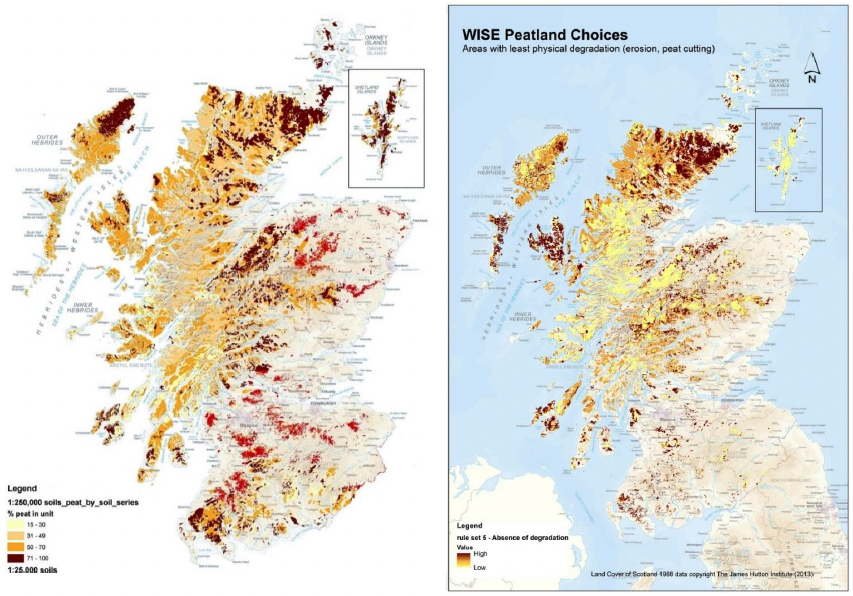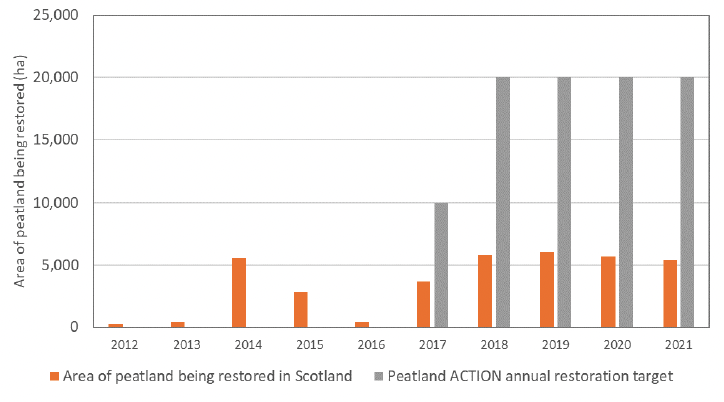Mobilising private investment in natural capital: report
This report looks at how to encourage responsible private investment into peatland restoration, including how to overcome barriers to scaling voluntary carbon markets to restore peatland in Scotland.
Section 1: Introduction
Objectives of the project
The "Mobilising Private Investment in Natural Capital" research project was commissioned by Scottish Government, in partnership with NatureScot, to explore how voluntary carbon markets can be harnessed to accelerate the delivery of high-integrity peatland restoration across Scotland. The project aims to understand both the financial and non-financial barriers to peatland restoration, the opportunities to scale-up restoration to deliver on Scotland's climate, biodiversity and community benefit targets, how public capital can be used most effectively to crowd-in private investment into peatland carbon markets and the wider lessons for developing other carbon markets.
This project builds on NatureScot and Finance Earth's 2021 report, "Facilitating Local Natural Capital Investment" which evaluated a range of funding and financing mechanisms to unlock investment in Scotland's natural capital. Based on a range of criteria, including market maturity, scalability, replicability, social and environmental outcomes, the report proposed the creation of two investment structures as effective mechanisms to catalyse investment into natural capital in Scotland:
- Scotland Carbon Fund (SCF): an investment vehicle enabling private investors to gain exposure to peatland restoration projects funded by the sale of carbon credits. The SCF provides a vehicle to facilitate private investment at scale into Scotland's peatlands, whilst also providing a model for funding other nature-based solutions; and
- Price Floor Guarantee (PFG): a mechanism that guarantees a minimum price floor for peatland projects aiming to sell carbon credits, de-risking private investment and project delivery. The PFG provides a solution to overcome some of the key barriers to market development and can enable improvements in the efficiency of public spending.
This report explores these two proposed mechanisms in more detail, providing recommendations regarding their design. The proposals and business case set out in this report are informed by an extensive process of stakeholder engagement with key groups engaged in, and affected by, peatland restoration in Scotland, spanning landowners, project developers, carbon buyers, investors and more. This report considers how these funding mechanisms should be deployed alongside grant funding to establish a coherent financing ecosystem to address key barriers to scaling high-integrity peatland restoration, and ultimately accelerate the delivery of nature restoration objectives in Scotland. Although the focus of the work is on peatlands, the findings and recommendations are also relevant to other nature markets in Scotland.
Context
The United Kingdom has one of the most depleted natural capital stocks on the planet.[3] Whilst public commitments are in place to begin to address this issue (e.g. UK government's 25 Year Environment Plan[4] in England and the natural capital indicators under the National Performance Framework in Scotland[5]). Within Scotland, public funding alone will not be sufficient to meet the targeted nature-related outcomes, with the financing gap estimated at up to £20 billion over the current decade[6]. Private capital will need to be leveraged to close this financing gap.
Peatlands cover over 2.5 million hectares (or one third) of Scotland and are of national and global significance. In good condition, they provide multiple benefits: storing carbon, supporting nature, reducing flood risk, cleaning water bodies, and providing places that can support physical and mental wellbeing. It is estimated that these landscapes store over 1.7 GtCO2e, yet 75% of Scotland's peatlands are degraded.[7]

Current land management practices, including land drainage, inappropriate muirburn, industrial pollution, grazing pressures and high deer populations have accelerated degradation. This represents a key challenge for Scotland, with degraded peatland acting as a major source of greenhouse gas (GHG) emissions. It is estimated that Scotland's degraded peatlands emit upwards of 6 MtCO2e annually[8] (equivalent to the annual emissions of 1.1 million combustion engine cars or 15% of Scotland's total net annual emissions).[9]
For Scotland to meet its climate change targets of net zero emissions by 2045, peatlands must be restored and preserved.[10] The restoration of peatlands can also deliver a multitude of additional economic and social benefits (Table 2), such as new jobs, providing livelihoods within local communities, and enhanced recreation and tourism opportunities.
| Benefit |
Description |
|---|---|
| Carbon storage and sequestration |
Contributes to climate change mitigation by avoiding emissions from degraded sites and gradually capturing and sequestering carbon in restored sites |
| Flood prevention |
Protects local communities and assets against flooding by slowing overland flow of water and reducing flood peaks |
| Biodiversity and wildlife habitat |
Underpins healthy habitats for a range of rare and endangered species |
| Water filtration |
Contributes to water quality (e.g., reduces water colour, nutrient loads and trace metals) |
| Beauty and heritage |
Constitutes a major attraction for recreational uses and tourists |
Peatland restoration: current funding landscape
The Scottish Government has taken a proactive approach to the restoration of peatland landscapes. Between 2012 and 2020, the Scottish Government has invested more than £30 million in the restoration of degraded peatlands in Scotland through its flagship Peatland ACTION Programme.[11] In February 2020, the Scottish Government committed a further £250 million to the restoration of 250,000 hectares of degraded peatlands by 2030.[12] The primary purpose of this funding is to support the upfront capital costs associated with peatland restoration, rather than the long-term maintenance costs.
Despite these commitments, current trends suggest that peatland restoration is not being undertaken at the pace and scale required to meet Scottish Government's 250,000 hectare target by 2030, nor the UK's Climate Change Committee's target of restoring 50% of the UK's upland peatlands by 2050,[13] with just over 30,000 hectares restored since 2012 (Figure 2).[14] It should also be noted that the current 250,000 hectares commitment represents just 20% of Scotland's degraded peatland.

Beyond public funding, there has been minimal investment in peatland restoration from private sources to date, including through voluntary carbon markets. In this context, the Scottish Government is keen to develop the attractiveness of carbon markets to both reduce dependence on public funds as well as deliver high impact, high-integrity peatland restoration at the pace and scale required.
The UK peatland carbon market
Emerging markets for ecosystem services represent a major opportunity to draw more private capital into nature restoration and conservation. Voluntary carbon markets in particular are developing rapidly, with an average growth rate internationally of 30% over the last three years.[16] Markets have benefited from a growing trend of businesses and organisations announcing net-zero targets.
In parallel, compliance "cap-and-trade" Emission Trading Schemes (ETS), such as the UK ETS, are also considering the inclusion of a carbon offsets allowance, as a substitute to emission allowances, on their trading platforms, which could represent another significant driver of demand in carbon credits.[17]
To ensure that voluntary carbon markets function with integrity and transparency, several codes of practice and standards have been developed to reassure market participants of the climate claims being made about projects. In the UK, the Peatland Code (PC) is a voluntary certification standard for UK-based peatland projects which aims to provide assurances to carbon buyers that the climate benefits being sold are real, quantifiable, additional and permanent.[18] Launched by the International Union for Conservation for Nature (IUCN) in 2015, the PC is one of only two standards in the UK that is government endorsed (the other being the Woodland Carbon Code). The PC provides businesses with a means to invest in peatland restoration projects through the purchase of carbon credits. As of 7th September 2022, the PC had 92 projects registered under the UK Land Carbon Registry, covering approximately 15,000ha of peatland.[19] To be noted, not all peatland is currently eligible to the PC due to the eligibility criteria summarised in Table 3 below. As such, further work would be needed to ascertain the area of peatland in Scotland currently eligible under the PC.
| Eligibility criteria |
Description |
|---|---|
| Peatland type |
Peatland type must be blanket or raised bog (forested bog currently excluded). The next version of the peatland code is likely to expand this criteria to other peatland types (e.g., fenlands peatlands). |
| Peatland depth |
A minimum of 75% of the peat depths recorded within each Assessment Unit must be greater than or equal to 50 cm. |
| Peatland condition |
Peatland condition must be 'Actively Eroding' or 'Drained' as defined in the PC 'field protocol'.[21] |
| Duration |
Project must be able to enter a minimum contract of 30 years. |
| Additionality |
Project must be additional i.e. it must require carbon finance to take place. |
In addition to the PC, there are other voluntary standards for projects looking to market the climate benefits of peatland restoration. For example, Verra has developed an internationally applicable standard for peatland restoration projects (VM0036 Methodology for Rewetting Drained Temperate Peatlands)[22]. However these other standards have not yet been used in the UK, likely due to the validation and verification processes being more complicated and expensive than the PC, especially for small scale projects and the low prices obtained (per tonne) on international voluntary markets for peatland carbon.
More recently, the Wilder Carbon standard has been developed by Kent Wildlife Trust to enable the generation of carbon credits from rewilding activities including peatland restoration, using metrics developed by the PC, and requiring the collection of biodiversity data using Defra's biodiversity offsetting metric. In contrast to the PC, it requires buyer checks to ensure those investing in projects have done everything possible to reduce emissions at source before offsetting their residual emissions. It also has long minimum contract lengths of 100 years, or 50 years with conservation covenants to ensure that projects are effectively permanent. Due to these requirements, it is likely that the majority of projects will be developed by eNGOs that own peatlands, such as the Wildlife Trusts, with limited scalability beyond these types of institutional landowner.[23]
Contact
Email: peter.phillips@gov.scot
There is a problem
Thanks for your feedback